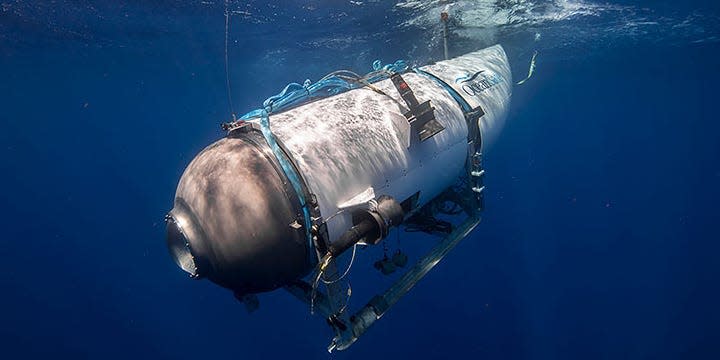These secret US Navy underwater microphones built to detect Soviet submarines may be what caught the sounds of the Titan submersible imploding

A Navy system detected what is believed to have been the implosion of the Titan submersible lost touring the Titanic.
That system, a naval expert said, is likely the undersea hydrophones of the Integrated Undersea Surveillance System.
That system, which was initially just the Sound Surveillance System, has been listening for enemy submarine activity for decades.
A somewhat secret US Navy system built to detect enemy submarine activity picked up sounds suspected to have been the catastrophic end of the Titan submersible lost touring the Titanic days before the search ended.
That system, a submarine warfare expert said, is likely the Integrated Undersea Surveillance System (IUSS), a component of which has been listening to undersea activity for decades.
After days of search-and-rescue efforts, the US Coast Guard revealed Thursday that debris had been discovered in the area where the OceanGate Expeditions' Titan submersible went missing and was "consistent with a catastrophic implosion of the vessel." All five crew members are presumed dead.
In the wake of these tragic revelations, The Wall Street Journal, citing officials involved in the search efforts, reported that sounds of what might have been the implosion were detected on Sunday by a secret Navy sensor system.
A senior US Navy official said in a statement provided to Insider that the sea service "conducted an analysis of acoustic data and detected an anomaly consistent with an implosion or explosion in the general vicinity of where the TITAN submersible was operating when communications were lost."
The Navy declined to identify the system that detected the anomaly and directed Insider back to the senior official's statement.
Since the early years of the Cold War, as concerns about the potential for submarines to wreak havoc beneath the waves grew in the wake of World War II, the Atlantic and Pacific oceans have been under constant surveillance by an array of hydrophones, or underwater microphones, scattered across the bottom of the ocean. This system, first constructed in the early 1950s, is called the Sound Surveillance System (SOSUS).
The installation of the SOSUS hydrophones on the sea floor was sold as being for oceanographic research purposes, but the actual purpose of these acoustic sensors was detecting the presence of and tracking the Soviet Union's submarines.
"The SOSUS arrays that they built during the Cold War, those are still around," Bryan Clark, a former submariner and current defense expert at the Hudson Institute, told Insider, noting that they've been upgraded and expanded over time.
As he explained in a recent report on undersea warfare, toward the end of the Cold War, the Navy augmented SOSUS with Surveillance Towed Array Sensor System (SURTASS) ships, creating a more capable system now known as the IUSS.
Though the system is known publicly, the exact locations of certain sensors and elements of the system are classified. Declassified location information from the 1970s, however, shows SOSUS elements positioned off the East and West coasts of the US near the submarine bases.
Clark said the reporting indicated that the SOSUS hydrophones are likely what detected the final moments of the Titan submersible. That assessment aligns with reporting from NPR, which said "the listening system the Navy used to register the noise is believed to be the Sound Surveillance System."
Although the IUSS array is a key component of the broader US anti-submarine warfare capabilities for both overseas and homeland defense, the development of quieter submarine technology from rivals like Russia and China have hindered its ability to provide adequate warning, meaning that potential submarine threats have to be addressed by ships, submarines, and aircraft.
"It's a big problem that the Navy has to sort of figure out a solution to," Clark said, but the system could detect something as loud as an implosion.
"They'll pick up noises like this," he said.
The senior Navy official said in the statement to Insider that though what it detected was not definitive, the information "was immediately shared with the Incident Commander to assist with the ongoing search and rescue mission."
"This information was considered with the compilation of additional acoustic data provided by other partners and the decision was made to continue our mission as a search and rescue and make every effort to save the lives on board," the official added.
As The New York Times reported in its confirmation of the earlier Journal story, the data was combined with information collected from sonobuoys on the surface and airborne assets.
In The Wall Street Journal report, an individual with direct knowledge of the situation said that "it looks that the Titan imploded on Sunday on its way down to the Titanic shortly after contact was lost at a depth of around 9,000 feet."
Read the original article on Business Insider


